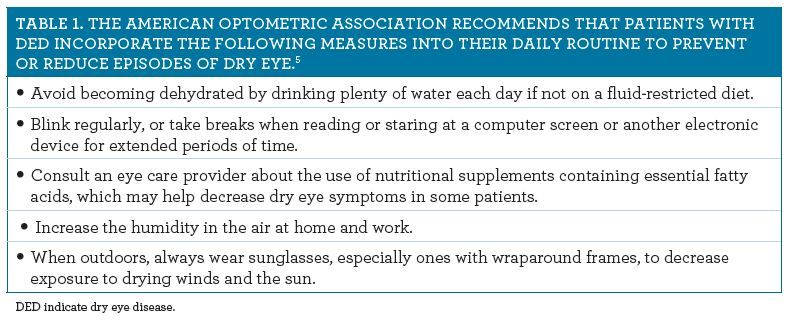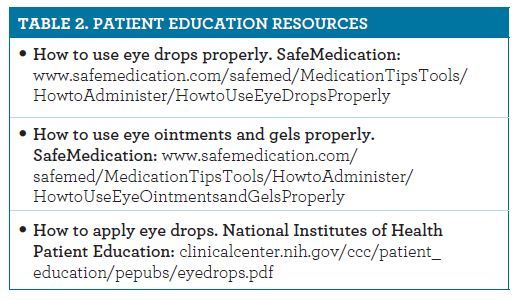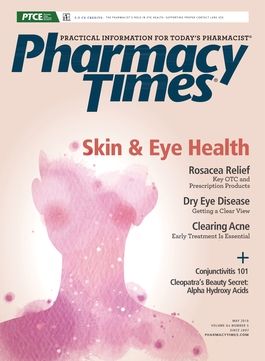Publication
Article
Pharmacy Times
Getting a Clear View: A Guide to Products for Preventing and Managing Dry Eye Disease
Author(s):
An estimated 10% to 30% of the population older than 40 years suffers from some degree of dry eye disease, according to the American Academy of Ophthalmology.
An estimated 10% to 30% of the population older than 40 years suffers from some degree of dry eye disease (DED), according to the American Academy of Ophthalmology.1,2 Moreover, an estimated 3.2 million women and 1.68 million men over 50 suffer from DED.1 DED, which is also sometimes referred to as dry eye syndrome or keratoconjunctivitis sicca, is considered the most prevalent ophthalmic disorder that affects the anterior eye and is most often associated with the aging process, especially in postmenopausal women.3-5 DED is a multifactorial disease of the tears and ocular surface that results in discomfort, tear film instability, and visual disturbance, with potential for damage to the ocular surface.2,3 DED can be classified as chronic or temporary. DED can be also attributed to Bell palsy, collagen disorders such as rheumatoid arthritis, corneal or eye lid defects, Sjögren syndrome, and thyroid-related eye disease.3,4 Other medical conditions associated with DED include diabetes, lupus, and scleroderma.3,4 Pharmacologic agents that have anticholinergic properties—including antihistamines, decongestants, and antihypertensives such as antidepressants, beta-blockers, and diuretics—are common causes of DED.3,4 Additionally, DED may be caused or exacerbated by allergens and environmental conditions such as dry climates, failure to blink regularly when staring for long periods at electronic devices, smoke, and wind.3,4 Laser eye surgery may also cause temporary dry eye.3,4

Pharmacists are in a critical position to identify the pharmacologic agents that can exacerbate or increase the risk of DED and counsel patients regarding the most efficacious means of preventing episodes of dry eye (see Tables 1 and 2).3,4 Additionally, pharmacists can be instrumental in aiding patients by educating and recommending the many nonprescription products to manage and treat mild to moderate DED as well as direct patients with chronic and severe cases of DED to seek further medical care from an ophthalmologist when warranted.

Clinical Presentation
Patients with DED may present with an array of symptoms. DED symptoms are typically worse at the end of the day, with prolonged use of eyes or with exposure to extreme environmental conditions.5 DED typically causes a feeling that something is in the eye or a gritty or scratchy sensation.3-6 Other DED symptoms include burning or stinging, discharge, and episodes of excess tearing that follow periods of dryness, pain, and redness in the eye.3-6 Individuals with DED may also report that their eyelids feel heavy, and they may experience blurred vision.
Treatments
Without proper, timely diagnosis and treatment, DED may result in damage to the ocular tissues, especially the corneal surface.3 In general, the primary goal of treating DED is to alleviate, control, and prevent the symptoms associated with dryness in the ocular area. The type of treatment selected is contingent on the degree and frequency of DED. Treatment of DED may involve the use of both nonpharmacologic measures such as the avoidance or removal of the offending agent when feasible, eyelid therapy including eyelid hygiene, and the use of warm compresses, as well as pharmacologic measures, such as artificial tears and nonmedicated ophthalmic ointments (see Table 3).3 Some eye care experts may also recommend the use of systemic omega-3 fatty acid supplements when no contraindications are present.3 The primary and initial self-treatment for mild to moderate DED is classically the use of ocular lubricants.3 Eye care providers often treat severe cases of DED with punctal plugs, which occlude the lacrimal drainage system to increase the available tear pool.3 For moderate to severe cases of DED, therapy may include the use of immunomodulating agents, such as the prescription drug topical cyclosporine, in conjunction with ocular lubricants.3

Artificial Tears
Ocular lubricants, such as artificial tear solutions, contain preservatives and inorganic electrolytes to achieve tonicity and sustain pH, as well as water-soluble polymeric systems.3 Preservative-free products are available, as well, and normally these products contain enhancing agents such as carboxymethyl cellulose, glycerin, hydroxyethyl cellulose, hydroxypropyl methylcellulose, methylcellulose, polycarbophil, polyethylene glycol 400, polysorbate 80, and polyvinyl alcohol.3
Artificial tear substitutes provide a barrier function and help improve the first-line defense at the level of conjunctival mucosa.3 Moreover, artificial tears assist in diluting various allergens and inflammatory mediators that may be present on the ocular surface and assist in flushing the ocular surface of these agents.3 In general, artificial tears are instilled once or twice daily, typically in the morning and again at bedtime. Patients should be reminded that artificial tear products containing preservatives may cause allergic reactions and should be immediately discontinued if a reaction occurs.3 Artificial tear products can be refrigerated to provide additional soothing comfort upon instillation, are considered very safe, and can be used as often as needed.
Nonmedicated Ophthalmic Ointments
The primary ingredients in nonprescription ophthalmic ointments include lanolin, which aids in the absorption of water-soluble medications and also inhibits evaporation; mineral oil, which assists the ointment in melting at body temperature; and white petrolatum, which acts as a lubricant and an ointment base.3 Nonmedicated ointments are considered the mainstay for treating minor ophthalmic disorders such as dry eye and minor eye irritation.3 In general, these products are to be used twice daily but can be administered more often depending on the patient’s needs.3 Because patients may complain about blurred vision when using ophthalmic ointments, pharmacists can recommend that patients should administer these ocular lubricants at bedtime to assist in keeping the ocular area moist during sleep and to improve the symptoms associated with DED upon waking.3
Conclusion
Prior to recommending any OTC products for DED, pharmacists should ascertain whether self-treatment is appropriate and refer patients to seek medical care when warranted. Patients experiencing severe episodes of DED, red or painful eyes, or signs of ocular infection should always be encouraged to seek medical care from an ophthalmologist to ensure proper treatment and to lessen the incidence of further ocular damage. Patients electing to use OTC products should be advised to seek care from an ophthalmologist for suggestions for alternative therapies, including prescription medications such as cyclosporine ophthalmic emulsion if the dry eye symptoms do not improve or worsen after self-treatment with OTC products.
Yvette C. Terrie, BSPharm, RPh, is a consultant pharmacist and a medical writer based in Haymarket, Virginia.
References
- Eye health statistics. American Academy of Ophthalmology website. aao.org/newsroom/eye-health-statistics. Accessed March 20, 2018.
- Foster CS. Dry eye disease (keratoconjunctivitis sicca). Medscape website. emedicine.medscape.com/article/1210417-overview. Updated October 9, 2017. Accessed March 20, 2018.
- Fiscella R, Jensen M. Ophthalmic disorders. In: Krinsky D, Berardi R, Ferreri S, et al, eds. Handbook of Nonprescription Drugs. 19th ed. Washington, DC: American Pharmacists Association; 2018.
- Facts about dry eye. National Eye Institute website. nei.nih.gov/health/dryeye/dryeye. Updated July 2017. Accessed March 23, 2018.
- Dry eye. American Optometric Association website. aoa.org/patients-and-public/eye-and-vision-problems/glossary-of-eye-and-vision-conditions/dry-eye?sso=y. Accessed March 20, 2018.
- Nordqvist C. What is dry eye and how can I get rid of it? Med News Today. medicalnewstoday.com/articles/170743.php. Updated January 11, 2018. Accessed March 20, 2018.







